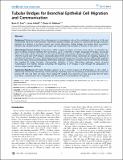Tubular bridges for bronchial epithelial cell migration and communication
Author(s)
Zani, Brett Greer; Indolfi, Laura; Edelman, Elazer R.
DownloadZani-2010-Tubular Bridges for.pdf (8.553Mb)
PUBLISHER_POLICY
Publisher Policy
Article is made available in accordance with the publisher's policy and may be subject to US copyright law. Please refer to the publisher's site for terms of use.
Terms of use
Metadata
Show full item recordAbstract
Background: Biological processes from embryogenesis to tumorigenesis rely on the coordinated coalescence of cells and
synchronized cell-to-cell communication. Intercellular signaling enables cell masses to communicate through endocrine
pathways at a distance or by direct contact over shorter dimensions. Cellular bridges, the longest direct connections
between cells, facilitate transfer of cellular signals and components over hundreds of microns in vitro and in vivo. Methodology/Principal Findings: Using various cellular imaging techniques on human tissue cultures, we identified two
types of tubular, bronchial epithelial (EP) connections, up to a millimeter in length, designated EP bridges. Structurally
distinct from other cellular connections, the first type of EP bridge may mediate transport of cellular material between cells,
while the second type of EP bridge is functionally distinct from all other cellular connections by mediating migration of
epithelial cells between EP masses. Morphological and biochemical interactions with other cell types differentially regulated
the nuclear factor-kB and cyclooxygenase inflammatory pathways, resulting in increased levels of inflammatory molecules
that impeded EP bridge formation. Pharmacologic inhibition of these inflammatory pathways caused increased
morphological and mobility changes stimulating the biogenesis of EP bridges, in part through the upregulation of
reactive oxygen species pathways. Conclusions/Significance: EP bridge formation appears to be a normal response of EP physiology in vitro, which is
differentially inhibited by inflammatory cellular pathways depending upon the morphological and biochemical interactions
between EP cells and other cell types. These tubular EP conduits may represent an ultra long-range form of direct
intercellular communication and a completely new mechanism of tissue-mediated cell migration.
Date issued
2010-01Department
Harvard University--MIT Division of Health Sciences and TechnologyJournal
PLoS ONE
Publisher
Public Library of Science
Citation
Zani, Brett G., Laura Indolfi, and Elazer R. Edelman. “Tubular Bridges for Bronchial Epithelial Cell Migration and Communication.” PLoS ONE 5.1 (2010): e8930. © 2010 Zani et al.
Version: Final published version